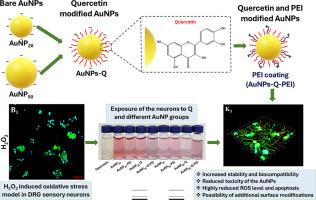Quercetin/Polyethyleneimine Modified Gold Nanoconjugates Inhibit Apoptosis and ROS Production Induced by Hydrogen Peroxide in DRG Sensory Neurons
IF 3.7
3区 医学
Q2 CHEMISTRY, MEDICINAL
引用次数: 0
Abstract
The basis of most neurological syndromes is the accumulation of free radical molecules. Quercetin is a polyphenolic bioflavonoid molecule and it has a very strong antioxidant effect by maintaining oxidative balance. There are many difficulties in the clinical use of quercetin due to its hydrophobic structure, low solubility, instability, poor oral bioavailability, and limited tissue-barrier penetration. Its synergistic use in complex with gold nanoparticles (AuNPs) could overcome these problems. AuNPs have recently emerged as an attractive candidate for delivery applications of various biomolecules and drugs. The aim of this study was to synthesize two different sized gold nanoparticles (AuNP20 and AuNP50) modified with polyethyleneimine (PEI) and quercetin, evaluate their potential neuroprotective effects on the in vitro oxidative stress model using DRG primary sensory neurons. It was shown that the antioxidant and anti-apoptotic ability of the bioflavonoid was preserved after exposure to the designed quercetin modified AuNPs. The PEI surface coating increased the stability and biocompatibility of the AuNPs in both sizes. It also potentially enables additional surface functionalization. This study indicates that designed nanoparticles (AuNP-Q-PEI) with different sizes could be a useful potential platform for the treatment of neurodegenerative syndromes or cancer diseases.

槲皮素/聚乙烯亚胺修饰金纳米共轭物抑制过氧化氢诱导的 DRG 感觉神经元凋亡和 ROS 生成
大多数神经综合症的基础是自由基分子的积累。槲皮素是一种多酚生物类黄酮分子,具有很强的抗氧化作用,能维持氧化平衡。由于槲皮素的疏水性结构、低溶解度、不稳定性、口服生物利用度差、组织屏障渗透有限等原因,槲皮素的临床应用存在许多困难。槲皮素与金纳米粒子(AuNPs)的协同使用可以克服这些问题。近来,AuNPs 已成为递送各种生物大分子和药物的极具吸引力的候选材料。本研究的目的是合成两种不同尺寸的金纳米粒子(AuNP20 和 AuNP50),并用聚乙烯亚胺(PEI)和槲皮素修饰,利用 DRG 初级感觉神经元评估它们对体外氧化应激模型的潜在神经保护作用。结果表明,生物类黄酮的抗氧化和抗凋亡能力在暴露于所设计的槲皮素修饰 AuNPs 后得以保留。PEI 表面涂层提高了两种尺寸 AuNPs 的稳定性和生物相容性。它还有可能实现更多的表面功能化。这项研究表明,设计出的不同尺寸的纳米粒子(AuNP-Q-PEI)可以成为治疗神经退行性综合症或癌症疾病的一个有用的潜在平台。
本文章由计算机程序翻译,如有差异,请以英文原文为准。
求助全文
约1分钟内获得全文
求助全文
来源期刊
CiteScore
7.30
自引率
13.20%
发文量
367
审稿时长
33 days
期刊介绍:
The Journal of Pharmaceutical Sciences will publish original research papers, original research notes, invited topical reviews (including Minireviews), and editorial commentary and news. The area of focus shall be concepts in basic pharmaceutical science and such topics as chemical processing of pharmaceuticals, including crystallization, lyophilization, chemical stability of drugs, pharmacokinetics, biopharmaceutics, pharmacodynamics, pro-drug developments, metabolic disposition of bioactive agents, dosage form design, protein-peptide chemistry and biotechnology specifically as these relate to pharmaceutical technology, and targeted drug delivery.

 求助内容:
求助内容: 应助结果提醒方式:
应助结果提醒方式:


